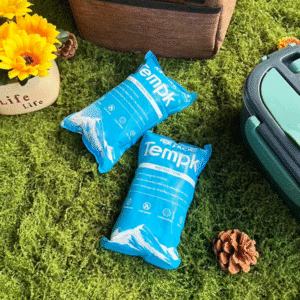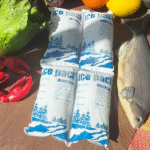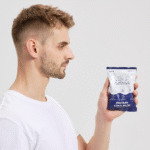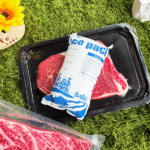Shipping temperature sensitive products in insulated boxes and dry ice packs requires careful planning. You need the right packaging, the correct amount of dry ice, and a clear understanding of safety and regulatory guidelines. hielo seco is much colder than water based ice and sublimates into gas, so your insulation and venting must be appropriate. Según la guía de la industria, the amount of dry ice needed depends on shipment duration: Por ejemplo, equal weight of dry ice and product can maintain frozen temperatures for up to 48 horas. En 2025 the cold chain industry is adopting new technologies like smart sensors and hybrid insulation, making it easier to maintain temperature integrity while reducing environmental impact. This guide offers a practical roadmap to help you ship perishables confidently.
How do insulated boxes and dry ice packs work together to keep goods frozen? We explain insulation materials, dry ice chemistry and the advantages of combining them.
How do you choose the right packaging and calculate the right amount of dry ice? Learn simple rules of thumb for different payload weights and transit times.
What safety and regulatory requirements apply in 2025? Understand labeling requirements, hazardous material rules and airline weight limits.
What are the latest trends and innovations in cold chain shipping? Explore sustainable production, hybrid packaging solutions and smart monitoring technology.
Consejos prácticos y preguntas frecuentes: Find answers to common questions like “How much dry ice do I need?” and “Is it safe to ship internationally?"
Why Use Insulated Boxes and Dry Ice Packs?
Core concept: Cajas aisladas minimize heat transfer, mientras paquetes de hielo seco provide intense cold by sublimating directly from solid carbon dioxide to gas at −78.5 °C. The combination keeps goods frozen without the mess of melted water. Generalmente, dry ice is the best choice for products that must remain frozen, whereas cold gel packs are better for chilled (arriba 0 °C) temperaturas. Por ejemplo, the FDA requires raw protein perishables to arrive at or below 40 °F (4.4 °C) and injectable medicines must stay within 2–8 °C. Dry ice achieves the lower range easily.
How Insulation Works
Insulation materials slow heat transfer from the environment into your shipment. Common types include expanded polystyrene (EPS) refrigeradores de espuma, poliuretano, corrugated cardboard with reflective liners, y paneles aislados al vacío. Each material offers different levels of thermal resistance (R value) y durabilidad. Para envíos cortos (<24 horas), a thin foil lined pouch may suffice; Para duraciones más largas, thicker foam or vacuum panels are better. A shipping guide from Insulated Products Corporation notes that the right insulated packaging depends primarily on transit time and the temperature requirements of your product. Longer transit times or products requiring lower temperatures call for higher performance insulation.
Hielo seco: Beneficios y consideraciones
Dry ice provides powerful cooling because it sublimates at −78.5 °C. Los beneficios incluyen:
Enfriamiento duradero: El hielo seco se sublima lentamente, keeping goods frozen longer than traditional ice.
Sin humedad: Porque el hielo seco se convierte directamente en gas, it leaves no water residue, preventing packaging damage or product spoilage.
Temperaturas ultrabajas: It easily keeps products below freezing for 24–72 hours, dependiendo de la cantidad y el aislamiento.
Consideraciones: Dry ice is extremely cold and can cause frostbite if handled improperly. It must be placed in vented containers, as carbon dioxide gas buildup can rupture sealed packages. Para envíos aéreos, regulations limit dry ice quantities to 2.5 kg por bulto en vuelos de pasajeros y hasta 200 kg on cargo aircraft. Non medical shipments using more than 5.5 lb (2.5 kilos) de hielo seco en EE.UU.. must comply with hazardous materials rules (49 CFR).
Choosing Between Gel Packs and Dry Ice
Gel packs are appropriate when goods need to stay chilled but not frozen. Gel packs maintain temperatures near 2–8 °C and are ideal when the product must not freeze. They also avoid hazardous material regulations and can offset heat for chocolates or cosmetics. Sin embargo, they are ineffective for products that must remain below 0 °C. El hielo seco es mejor para productos congelados, como helado, seafood and biological samples.
Selecting Insulated Boxes: Material and Design Choices
Different insulated boxes serve different needs. Here are key factors to consider:
Material Options
| Material | Rendimiento térmico (R value) | Aplicaciones típicas | Beneficio práctico para usted |
| EPS Foam Coolers | Moderado (R value ~3.6 per in) | Envíos de alimentos, productos farmaceuticos | Asequible y ampliamente disponible |
| Espuma de poliuretano | Más alto (R value ~6–7 per in) | Productos farmacéuticos de alto valor, biotecnología | Improved insulation for long trips |
| Corrugated Cardboard + Frustrar | Variable | Kits de comida, comestibles | Ligero y reciclable |
| Paneles aislados al vacío (personaje) | muy alto (R value 25–30) | Envíos especiales (p.ej., vacunas) | Extremely efficient but expensive |
Choosing thickness: Un aislamiento más grueso prolonga el tiempo de tránsito. Para envíos sobre 48 horas, consider multi piece foam panels or vacuum insulated boxes. According to IPC, insulated box liners with greater thickness provide higher thermal resistance, making them suitable for shipments lasting more than 24 horas.
Size and Payload Considerations
When sizing your box, leave enough space for dry ice and protective cushioning around the product. Too little space restricts airflow and may cause uneven cooling; too much empty space increases sublimation rate. Use inserts or dividers to keep products from touching dry ice directly, which could cause freeze damage. A snug fit helps maintain consistent temperature.
Sealing and Venting
Even though the lid should fit tightly to prevent warm air ingress, never completely seal a dry ice shipment. Venting holes allow CO₂ gas to escape and prevent pressure buildup. Para envíos a través del país, select insulated boxes with built in venting or leave small gaps at corners. Use moisture resistant tape to secure the lid while maintaining ventilation.
Calculating Dry Ice Requirements
¿Cuánto hielo seco debes usar?? This question is central to maintaining product integrity and preventing excess weight or hazard. General rules of thumb include:
Half the product’s weight for overnight shipments: Packing half the weight of the payload in dry ice keeps goods frozen up to 24 horas.
Equal weight for 48 horas: Equal weight of dry ice and product extends the frozen state to around 48 horas.
1.5× the weight for 72 horas: For 72 hour transit, prepare about 1.5 veces el peso del producto en hielo seco.
5–10 lb per 10–15 lb of goods per 24 horas: Another guideline recommends using 5–10 lb of dry ice for every 10–15 lb of product per 24 horas.
The required amount depends on external temperature, insulation efficiency and starting temperature of the goods. Always test your packout (packaging configuration) under expected conditions.
Colocación de hielo seco
The arrangement of dry ice in the box affects performance. Place dry ice on top of the product, as cold air sinks and ensures the payload remains frozen. Para envíos más grandes, a dual layer approach with dry ice on top and bottom can extend cooling. A rule of thumb suggests placing most of the dry ice on top; Por ejemplo, por un 30 lb payload requiring 24–48 hours, usar 20 lb of dry ice on top and 10 lb on the bottom.
Dry Ice Calculator Table
| Peso de carga útil | Hielo seco (Arriba) para <12 h | Hielo seco (Arriba) durante 24 a 48 h | Hielo seco (Arriba) for 48–72 h | Perspectiva práctica |
| 5 lb | 3 lb | 5 lb | 10 lb | Para paquetes pequeños, half the weight suffices for overnight shipping. |
| 10 lb | 5 lb | 10 lb | 15 lb | Equal weight ensures 48 h frozen state. |
| 20 lb | 10 lb | 20 lb | 30 lb | Additional dry ice required for extended transit. |
| 40 lb | 15 lb | 25 lb | 40 lb | Heavier payloads demand proportionally more dry ice. |
| 50 lb | 15 lb | 35 lb | 50 lb | Para largos envíos, plan 1:1 ratio or greater. |
Packing Techniques and Safety Guidelines
Successful cold chain shipping goes beyond selecting the right insulation and quantity of dry ice. Follow these best practices to protect both your products and anyone handling the shipment.
Proceso de embalaje paso a paso
Pre condition your box: Make sure the insulated box and dry ice are as cold as possible before packing. Keep dry ice in a freezer until ready.
Wrap the product: Place items in leak proof primary packaging. Para la comida, vacuum sealed bags reduce moisture and improve shelf life.
Add cushioning: Use foam inserts or bubble wrap to prevent movement and insulate further. Do not let the product touch dry ice directly.
Agregar hielo seco: Place the calculated amount of dry ice on top of the product. Use multiple smaller blocks or pellets for even distribution. If extended cooling is required, place additional dry ice below the product.
Aventer el contenedor: Ensure there are vent holes or leave a small gap under the lid. Use breathable tape (no hermético) around the box edges.
Etiquetar el paquete: Clearly mark the box with “Dry Ice” or “Carbon Dioxide, Sólido,” include the Número de la ONU 1845 y el peso neto del hielo seco. Add a Class 9 hazard label for hazardous material compliance.
Record shipment details: Document the amount of dry ice and expected sublimation time. Provide handling instructions for recipients.
Manejo de seguridad
Use equipo de protección: Use thermally insulated gloves and goggles to avoid frostbite.
Prevenir la acumulación de CO₂: Nunca coloque hielo seco en recipientes herméticos. Always store it in well ventilated areas.
Deshacerse de manera responsable: Deje que el hielo seco sobrante se sublime en un área ventilada.. Never pour dry ice down a sink; El frío extremo puede dañar las tuberías..
Regulatory Requirements in 2025
Dry ice shipments are regulated because carbon dioxide is considered a hazardous material. Key compliance points include:
UN number and Class 9 etiqueta: Packages must display “UN 1845” and a Class 9 etiqueta de peligro.
Weight declaration: The net weight of dry ice must be clearly marked.
Embalaje ventilado: Containers must allow CO₂ gas to escape during transit.
Air transport limits: La Asociación Internacional de Transporte Aéreo (IATA) restricts dry ice to 2.5 kg por bulto en vuelos de pasajeros y hasta 200 kg en vuelos de carga. Other guidelines require labeling and hazard communication.
A NOSOTROS. regulaciones (49 CFR): Envíos no médicos que contengan más de 5.5 lb (2.5 kilos) of dry ice require compliance with Title 49 del Código de Reglamentos Federales.
Following these rules protects carriers and recipients, reduces the risk of fines, and ensures your packages aren’t delayed or rejected.
Ejemplo del mundo real
Estudio de caso: A biotech firm needed to send vaccine samples cross country. By packing the vials in a polyurethane insulated box with 1.5 veces el peso del producto en hielo seco, the shipment remained below −20 °C for 72 horas. The firm used vented packaging, wore insulated gloves during loading, and adhered to IATA labeling rules. Como resultado, the vaccines arrived intact, with no temperature excursions or regulatory issues.
Maintaining Temperature During Transit
Shipping temperature sensitive goods isn’t only about the initial packout; the entire journey matters. Use these strategies to maintain temperature and reduce the risk of spoilage.
Monitoring Devices
En 2025, sensores de temperatura inteligentes y registradores de datos are widely available. These devices track temperature and humidity in real time, sending alerts if conditions deviate from the acceptable range. You can embed sensors inside the box or attach them to the exterior. Some sensors integrate with mobile apps or logistics dashboards, allowing you to monitor shipments anywhere.
Soluciones de enfriamiento híbrido
Hybrid solutions combine dry ice with gel packs or materiales de cambio de fase (PCM) to extend cooling while reducing dry ice usage. PCMs maintain specific temperature ranges (p.ej., 0 °C, 5 °C, −20°C) y se puede reutilizar. By pairing a small amount of dry ice with PCMs, you can achieve stable temperatures, limit CO₂ emissions and reduce shipping costs.
Route Optimization and Speed
El tiempo es crítico. The faster a shipment travels, the less dry ice is needed. Partner with carriers offering overnight or two day service. AI powered logistics platforms help plan routes, anticipate delays and optimize cooling strategies. Para envíos a través del país, choose services with minimal transfers to reduce the risk of temperature spikes.
2025 Tendencias y perspectivas del mercado
Keeping up with industry trends helps you stay competitive and compliant. Here are the notable developments shaping insulated boxes and dry ice shipping in 2025.
Producción de hielo seco sostenible
Environmental concerns have prompted suppliers to adopt greener production methods. Manufacturers increasingly capture CO₂ from industrial processes like ammonia synthesis to produce dry ice, reducing the overall carbon footprint. Companies are also exploring renewable energy sources for their production facilities.
Hybrid Packaging and PCMs
Hybrid packouts that combine dry ice with PCMs están ganando tracción. These solutions minimize carbon dioxide usage while maintaining required temperatures. They also reduce the weight of shipments, lowering transportation costs and emissions.
Smart Packaging and Tracking
Innovaciones como sensores de CO₂ inteligentes y Etiquetas con código QR provide real time tracking and temperature monitoring. Some systems integrate with blockchain to record every step of the cold chain, enhancing transparency and traceability. These technologies reduce waste by allowing corrective action before temperature excursions occur.
Automation and AI in Logistics
Automation plays an increasing role in cold chain logistics. Automated systems handle dry ice packaging, reducing human error and improving consistency. AI driven tools predict how weather conditions and transit times will affect cooling requirements, enabling precise dry ice calculations and route adjustments.
Market Growth and Opportunities
The cold chain packaging market is booming. En los EE.UU., the market was valued at USD 7.97 mil millones en 2024 y se prevé que crecerá a una tasa de crecimiento anual compuesta (Tocón) de 15.6 % entre 2025 y 2030. Growth drivers include increased demand for processed and frozen foods, the rise of e commerce and online grocery shopping, and strict temperature control requirements in the pharmaceutical sector. Insulated containers and boxes made up the largest revenue share in 2024, reflecting their importance in cold chain logistics. Cold packs are expected to grow at a CAGR de 17.6 % due to the popularity of meal kit delivery services and advances in cold pack materials. Innovaciones como paneles aislados al vacío (VIP) y bio based polymers are improving insulation and sustainability.
Preguntas frecuentes
Pregunta 1: How much dry ice do I need for a 2 day shipment? A 2 day (48hora) shipment generally requires equal weight of dry ice to the product, o sobre 5–10 lb of dry ice per 10–15 lb of goods per day. Para envíos a través del país, plan around 20 lb de hielo seco para 2 días.
Pregunta 2: ¿Puedo combinar hielo seco con paquetes de gel o PCM?? Sí. Combining dry ice with gel packs or PCMs slows down sublimation, extends cooling duration and reduces CO₂ emissions. Hybrid packouts are particularly useful for shipments requiring strict temperature control but not ultra low temperatures.
Pregunta 3: ¿Es seguro enviar hielo seco a nivel internacional?? Dry ice can be shipped internationally, but you must comply with the regulations of both origin and destination countries. Los envíos aéreos están limitados a 2.5 kilos (5.5 lb) of dry ice per package on passenger aircraft and up to 200 kg en vuelos de carga.
Pregunta 4: What type of insulated box should I use? Choose an insulated box based on transit time and temperature requirements. Para 24 horas o menos, a standard EPS foam box may suffice; for longer durations or extremely low temperatures, opt for thicker foam or vacuum insulated panels.
Pregunta 5: ¿Cómo estoy dispuesto a sobrantes de hielo seco?? Deje que el hielo seco restante se sublime en un área bien ventilada.. Never place it in a sink or sealed container.
Resumen y recomendaciones
Shipping perishables safely in insulated boxes with dry ice packs hinges on four pillars: Elegir el aislamiento correcto, calcular la cantidad correcta de hielo seco, ensuring proper ventilation and labeling, y adhering to safety and regulatory guidelines. Dry ice is ideal for frozen goods, while gel packs or PCMs are better for chilled items. General rules suggest using half to 1.5 times the product’s weight in dry ice depending on transit length. Utilice equipo de protección, envasado ventilado, and clearly mark packages with the UN 1845 etiqueta. Embrace emerging technologies like smart sensors and hybrid packouts to enhance reliability and sustainability.
Pasos procesables
Evalúe las necesidades de temperatura de su producto (congelado VS. enfriado) and shipping duration.
Select an insulated box with appropriate material and thickness. Choose between EPS, polyurethane or vacuum insulated panels depending on transit time and budget.
Calcular la cantidad de hielo seco. using guidelines (p.ej., half the product weight for overnight shipments, igual peso para 48 horas). Use a table or calculator for accuracy.
Empacar adecuadamente: Pre condition packaging, wrap products, add cushioning, colocar hielo seco encima, y ventilar el contenedor.
Seguir las regulaciones: Etiqueta con “Hielo seco,"Y 1845, peso neto; usar equipo de protección; comply with weight limits.
Monitorear envíos: Use temperature sensors and consider hybrid cooling solutions for extended duration or environmental benefits.
Acerca de Tempk
Templ specializes in cold chain solutions, offering a range of cajas aisladas, paquetes de hielo seco, paquetes de gel, phase change materials and smart monitoring devices. We help clients in food, pharmaceuticals and biotechnology maintain product quality throughout transit. Nuestra R&D team develops eco friendly materials and hybrid packouts to reduce carbon footprint while ensuring reliable temperature control. With decades of experience and compliance expertise, we empower businesses to streamline logistics, encontrarse 2025 regulaciones and deliver perishable goods safely. Para soluciones personalizadas, contact our team for professional guidance.
























